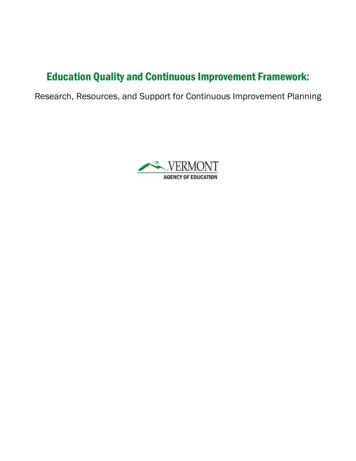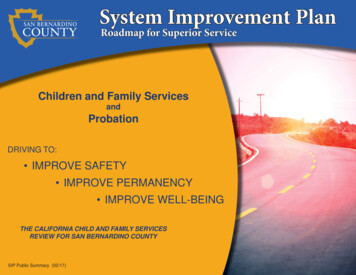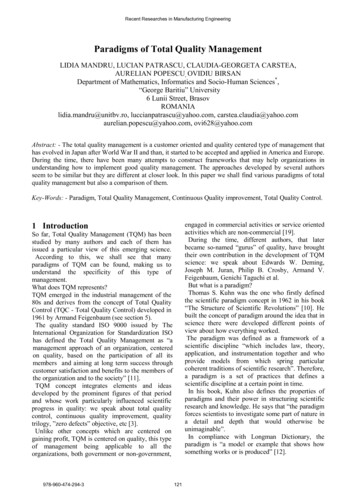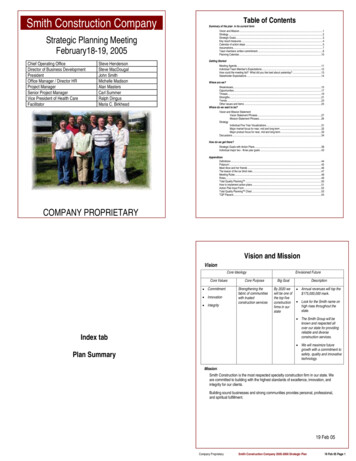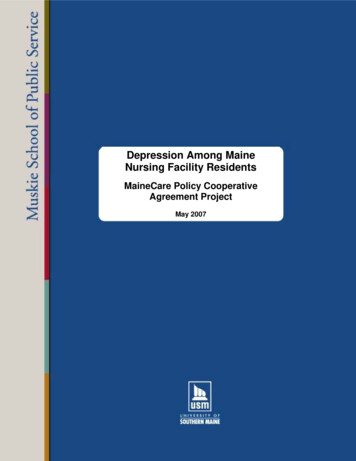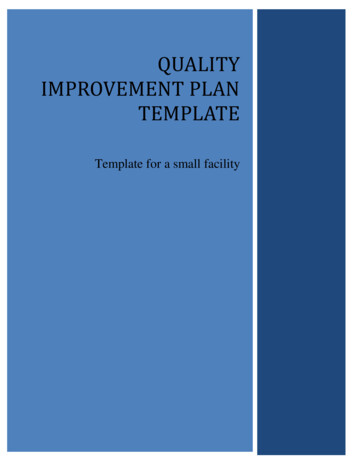
Transcription
QUALITYIMPROVEMENT PLANTEMPLATETemplate for a small facility
Quality Improvement PlanFacilityDate of the Current PlanSection 1IntroductionIntroduction : Mission, Vision, Scope of Service (Describe briefly the Facility’s program thatwill be covered by this Plan, including the Facility’s Name’s mission and vision, the types of servicesprovided, its relative size, etc,)The following Quality Improvement Plan serves as the foundation of the commitment of thethis Facility’s Name to continuously improve the quality of the treatment and services itprovides.Quality. Quality services are services that are provided in a safe, effective, recipientcentered, timely, equitable, and recovery-oriented fashion.(Facility’s Name ) is committed to the ongoing improvement of the quality of care itsconsumers receive, as evidenced by the outcomes of that care. The organizationcontinuously strives to ensure that: The treatment provided incorporates evidence based, effective practices;The treatment and services are appropriate to each consumer’s needs, and availablewhen needed;Risk to consumers, providers and others is minimized, and errors in the delivery ofservices are prevented;Consumers’ individual needs and expectations are respected; consumers – or thosewhom they designate – have the opportunity to participate in decisions regardingtheir treatment; and services are provided with sensitivity and caring;Procedures, treatments and services are provided in a timely and efficient manner,with appropriate coordination and continuity across all phases of care and allproviders of care.Quality Improvement Principles. Quality improvement is a systematic approach toassessing services and improving them on a priority basis. The (Facility’s Name) approachto quality improvement is based on the following principles: Customer Focus. High quality organizations focus on their internal and externalcustomers and on meeting or exceeding needs and expectations.
Recovery-oriented. Services are characterized by a commitment to promoting andpreserving wellness and to expanding choice. This approach promotes maximumflexibility and choice to meet individually defined goals and to permit person-centeredservices. Employee Empowerment. Effective programs involve people at all levels of theorganization in improving quality. Leadership Involvement. Strong leadership, direction and support of qualityimprovement activities by the governing body and CEO are key to performanceimprovement. This involvement of organizational leadership assures that qualityimprovement initiatives are consistent with provider mission and/or strategic plan. Data Informed Practice. Successful QI processes create feedback loops, using datato inform practice and measure results. Fact-based decisions are likely to be correctdecisions. Statistical Tools. For continuous improvement of care, tools and methods areneeded that foster knowledge and understanding. CQI organizations use a definedset of analytic tools such as run charts, cause and effect diagrams, flowcharts,Pareto charts, histograms, and control charts to turn data into information. Prevention Over Correction. Continuous Quality Improvement entities seek todesign good processes to achieve excellent outcomes rather than fix processes afterthe fact. Continuous Improvement. Processes must be continually reviewed and improved.Small incremental changes do make an impact, and providers can almost always findan opportunity to make things better.Continuous Quality Improvement Activities. Quality improvement activities emerge froma systematic and organized framework for improvement. This framework, adopted by thehospital leadership, is understood, accepted and utilized throughout the organization, as aresult of continuous education and involvement of staff at all levels in performanceimprovement. Quality Improvement involves two primary activities: Measuring and assessing the performance of Facility’s Name services through thecollection and analysis of data. Conducting quality improvement initiatives and taking action where indicated,including the design of new services, and/or improvement of existing services.The tools used to conduct these activities are described in Appendix A, at the end of this Plan.-3-
Section 2Leadership and OrganizationLeadership. The key to the success of the Continuous Quality Improvement process isleadership. The following describes how the leaders of the ( Facility’s Name) Facility’s Nameprovide support to quality improvement activities.The Quality Improvement Committee provides ongoing operational leadership ofcontinuous quality improvement activities at the Facility’s Name. It meets at least monthly ornot less than ten (10) times per year and consists of the following individuals: (List titles ofcommittee members. The membership should include a recipient/family member for adult settings anda family member for children settings. Indicate the Chairperson of the Committee.)The responsibilities of the Committee include: Developing and approving the Quality Improvement Plan.As part of the Plan, establishing measurable objectives based upon prioritiesidentified through the use of established criteria for improving the quality and safetyof Facility’s Name services.Developing indicators of quality on a priority basis.Periodically assessing information based on the indicators, taking action asevidenced through quality improvement initiatives to solve problems and pursueopportunities to improve quality.Establishing and supporting specific quality improvement initiatives.Reporting to the Board of Directors on quality improvement activities of the Facility’sName on a regular basis.Formally adopting a specific approach to Continuous Quality Improvement (such asPlan-Do-Check-Act: PDCA).The Board of Directors also provides leadership for the Quality Improvement process asfollows: Supporting and guiding implementation of quality improvement activities at theFacility’s Name.Reviewing, evaluating and approving the Quality Improvement Plan annually.(Describe how leadership will support Facility’s Name’s QI Program.)The Leaders support QI activities through the planned coordination and communication ofthe results of measurement activities related to QI initiatives and overall efforts to-4-
continually improve the quality of care provided. This sharing of QI data and information isan important leadership function. Leaders, through a planned and shared communicationapproach, ensure the Board of Directors, staff, recipients and family members haveknowledge of and input into ongoing QI initiatives as a means of continually improvingperformance.This planned communication may take place through the following methods; Story boards and/or posters displayed in common areas Recipients participating in QI Committee reporting back to recipient groups Sharing of the Facility’s Name’s annual QI Plan evaluation Newsletters and or handoutsPlease describe your Facility’s Names method and/or mechanism for communication to recipients,staff andleadership.Section 3Goals and ObjectivesThe Quality Improvement Committee identifies and defines goals and specific objectives tobe accomplished each year. These goals include training of Facility’s Nameal andadministrative staff regarding both continuous quality improvement principles and specificquality improvement initiative(s). Progress in meeting these goals and objectives is animportant part of the annual evaluation of quality improvement activities.The following are the ongoing long term goals for the (Facility’s Name) QI Program and thespecific objectives for accomplishing these goals for the year . (Indicate the currentyear.) To implement quantitative measurement to assess key processes or outcomes; (Anexample of an objective involving quantitative measurement: The average numberof “no shows” will be reduced overall by 30% from its current average ofwithin the next 12 months.) To bring managers, Facility’s Name, and staff together to review quantitative dataand major Facility’s Name adverse occurrences to identify problems; To carefully prioritize identified problems and set goals for their resolution; To achieve measurable improvement in the highest priority areas; To meet internal and external reporting requirements;-5-
To provide education and training to managers, Facility’s Nameians, and staff; (Anexample of an objective involving education and training; 100% of all managers,and staff will be trained in the principles and practices of Quality Improvement bydate .)To develop or adopt necessary tools, such as practice guidelines, consumer surveysand quality indicators.List here your goals and objectives for the current year. Selection of your goals may be taken fromthe list provided above. You do not need to select all of these goals. The list should be tailored toyour program and include specific objectives - ways in which these goals will be accomplished. Theobjective(s) for each of your selected goals need to be specific and measurable. Specific andmeasurable means that you will be able to clearly determine whether the objectives have been met atthe end of the year by using a specified set of QI tools. (See Appendix A.) At least one of the goalsand its corresponding objective(s) should concern staff education related to your qualityimprovement activities.-6-
Section 4Performance MeasurementPerformance Measurement is the process of regularly assessing the resultsproduced by the program. It involves identifying processes, systems and outcomesthat are integral to the performance of the service delivery system, selectingindicators of these processes, systems and outcomes, and analyzing informationrelated to these indicators on a regular basis. Continuous Quality Improvementinvolves taking action as needed based on the results of the data analysis and theopportunities for performance they identify.The purpose of measurement and assessment is to: Assess the stability of processes or outcomes to determine whether there is anundesirable degree of variation or a failure to perform at an expected level. Identify problems and opportunities to improve the performance of processes. Assess the outcome of the care provided. Assess whether a new or improved process meets performance expectations.Measurement and assessment involves: Selection of a process or outcome to be measured, on a priority basis. Identification and/or development of performance indicators for the selected processor outcome to be measured. Aggregating data so that it is summarized and quantified to measure a process oroutcome. Assessment of performance with regard to these indicators at planned and regularintervals. Taking action to address performance discrepancies when indicators indicate that aprocess is not stable, is not performing at an expected level or represents anopportunity for quality improvement. Reporting within the organization on findings, conclusions and actions taken as aresult of performance assessment. Selection of a Performance Indicator. A performance indicator is a quantitativetool that provides information about the performance of a Facility’s Name’s process,services, functions or outcomes. Selection of a Performance Indicator is based onthe following considerations:-7-
Relevance to mission - whether the indicator addresses the population served whether it addresses the practice’s important process that is: high volume problem prone or high riskCharacteristics of a Performance Indicator. Factors to consider in determining whichindicator to use include; Scientific Foundation: the relationship between the indicator and the process, systemor facility’s outcome being measured Validity: whether the indicator assesses what it purports to assess Resource Availability: the relationship of the results of the indicator to the costinvolved and the staffing resources that are available Consumer Preferences: the extent to which the indicator takes into account individualor group (e.g., racial, ethnic, or cultural) preferences Meaningfulness: whether the results of the indicator can be easily understood, theindicator measures a variable over which the program has some control, and thevariable is likely to be changed by reasonable quality improvement efforts.(Describe the factors which you will consider in selecting a measure of quality.)The Performance Indicator Selected for the (Facility’s Name) Quality ImprovementPlan. For purposes of this plan, an indicator(s) comprises five key elements: name,definition, data to be collected, the frequency of analysis or assessment, and preliminaryideas for improvement. The following Table presents each performance indicator currentlyin use by the Facility’s Name, along with the corresponding descriptors.-8-
Measure of Service Quality (Complete this table for each indicator which is selected.Note that only one indicator is required during the first year of the agreement.)NameName. Usually a brief two or three word title.DefinitionDefinition. With detail, explain the name by including thedata elements and the type of numerical value to be usedto express the indicator (percentage, rate, number ofoccurrences etc.).Data CollectionDescribe how the data will be collected as well as themethod and frequency of collection, and who will collectthe data.AssessmentFrequencyState how often the Quality Improvement Committee willassess information associated with the indicator.Assessment. Assessment is accomplished by comparing actual performance on anindicator with: Self over time. Pre-established standards, goals or expected levels of performance. Information concerning evidence based practices. Other practices/clinics/organizations or similar service providers.(List here the assessment strategies you will use. See APPENDIX A, attached, for examples ofperformance improvement tools.)-9-
Section 5Quality Improvement InitiativeOnce the performance of a selected process has been measured, assessed and analyzed,the information gathered by the above performance indicator(s) is used to identify acontinuous quality improvement initiative to be undertaken. The decision to undertake theinitiative is based upon Facility’s Name priorities. The purpose of an initiative is to improvethe performance of existing services or to design new ones. The model utilized atFacility’s Name is called Plan-Do-Check-Act (PDCA). (Modify the following as appropriate foryour program. If you choose a model other than PDCA, describe the model here.)# Plan - The first step involves identifying preliminary opportunities for improvement.At this point the focus is to analyze data to identify concerns and to determineanticipated outcomes. Ideas for improving processes are identified. This steprequires the most time and effort. Affected staff or people served are identified, datacompiled, and solutions proposed. (For tools used during the planning stage, seesections “a” thru “k” in APPENDIX: A. )# Do - This step involves using the proposed solution, and if it proves successful, asdetermined through measuring and assessing, implementing the solution usually ona trial basis as a new part of the process.# Check - At this stage, data is again collected to compare the results of the newprocess with those of the previous one.# Act - This stage involves making the changes a routine part of the targeted activity.It also means “Acting” to involve others (other staff, program components orconsumers) - those who will be affected by the changes, those whose cooperation isneeded to implement the changes on a larger scale, and those who may benefit fromwhat has been learned. Finally, it means documenting and reporting findings andfollow up.-10-
Section 6EvaluationAn evaluation is completed at the end of each calendar year. The annual evaluation isconducted by the Facility’s Name and kept on file in the Facility’s Name, along with theQuality Improvement Plan. These documents will be reviewed by the Office of MentalHealth as part of the Facility’s Name certification process.The evaluation summarizes the goals and objectives of the Facility’s Name’s QualityImprovement Plan, the quality improvement activities conducted during the past year,including the targeted process, systems and outcomes, the performance indicators utilized,the findings of the measurement, data aggregation, assessment and analysis processes,and the quality improvement initiatives taken in response to the findings.# Summarize the progress towards meeting the Annual Goals/Objectives.# For each of the goals, include a brief summary of progress including progress inrelation to training goal(s).# Provide a brief summary of the findings for each of the indicators you used during theyear. These summaries should include both the outcomes of the measurementprocess and the conclusions and actions taken in response to these outcomes.Summarize your progress in relation to your Quality Initiative(s). For each initiative,provide a brief description of what activities took place including the results on yourindicator. What are the next steps? How will you “hold the gains.” Describe anyimplications of the quality improvement process for actions to be taken regardingoutcomes, systems or outcomes at your program in the coming year.)# Recommendations: Based upon the evaluation, state the actions you see asnecessary to improve the effectiveness of the QI Plan.-11-
APPENDIX A. Quality Improvement ToolsFollowing are some of the tools available to assist in the Quality Improvement process.a. Flow Charting: Use of a diagram in which graphic symbols depict the nature and flowof the steps in a process. This tool is particularly useful in the early stages of a projectto help the team understand how the process currently works. The “as-is” flow chartmay be compared to how the process is intended to work. At the end of the project, theteam may want to then re-plot the modified process to show how the redefined processshould occur. The benefits of a flow chart are that it:1) Is a pictorial representation that promotes understanding of the process2) Is a potential training tool for employees3) Clearly shows where problem areas and processes for improvement are.FLOW CHART tionYesFlow charting allows the team to identifythe actual flow-of-event sequence in aprocess.TerminatorNoDocumentb. Brainstorming: A tool used by teams to bring out the ideas of each individual andpresent them in an orderly fashion to the rest of the team. Essential tobrainstorming is to provide an environment free of criticism. Team membersgenerate issues and agree to “defer judgement” on the relative value of each idea.Brainstorming is used when one wants to generate a large number of ideas aboutissues to tackle, possible causes, approaches to use, or actions to take. Theadvantages of brainstorming are that it:1)2)3)4)Encourages creativityRapidly produces a large number of ideasEqualizes involvement by all team membersFosters a sense of ownership in the final decision as all members activelyparticipate5) Provides input to other tools: “brain stormed” ideas can be put into an affinitydiagram or they can be reduced by multi-voting.c. Decision-making Tools: While not all decisions are made by teams, two tools canbe helpful when teams need to make decisions.-12-
1) Multi-voting is a group decision-making technique used to reduce a long list ofitems to a manageable number by means of a structured series of votes. Theresult is a short list identifying what is important to the team. Multi-voting is usedto reduce a long list of ideas and assign priorities quickly with a high degree ofteam agreement.2) Nominal Group technique-used to identify and rank issues.d. Affinity Diagram: The Affinity Diagram is often used to group ideas generated bybrainstorming. It is a tool that gathers large amounts of language data (ideas,issues, opinions) and organizes them into groupings based on their naturalrelationship. The affinity process is a good way to get people who work on acreative level to address difficult, confusing, unknown or disorganized issues. Theaffinity process is formalized in a graphic representation called an affinity diagram.This process is useful to:1)2)Sift through large volumes of data.Encourage new patterns of thinking.As a rule of thumb, if less than 15 items of information have been identified, theaffinity process is not needed.e. Cause and Effect Diagram (also called a fishbone or Ishakawa diagram): Thisis a tool that helps identify, sort, and display. It is a graphic representation of therelationship between a given outcome and all the factors that influence the outcome.This tool helps to identify the basic root causes of a problem. The structure of thediagram helps team members think in a very systematic way. The benefits of acause-and-effect diagram are that it:1) Helps the team to determine the root causes of a problem or qualitycharacteristic using a structured approach2) Encourages group participation and utilizes group knowledge of the process3) Uses an orderly, easy-to-read format to diagram cause-and-effect relationships4) Indicates possible causes of variation in a process5) Increases knowledge of the process6)Identifies areas where data should be collected for additional study.CAUSE & EFFECT DIAGRAMPOLICIES ng policiesUnsafe conditionsNo policies presentSecurity problemsinadequate policiesUndesiredOutcomeHuman Errornot availableStaffingCompetencyInsufficient suppliesHumanResourcesSUPPLIES,EQUIPMENT &MATERIALSOTHERAREAS-13-Cause and effectdiagrams allow the teamto identify and graphicallydisplay all possiblecauses related to aprocess, procedure orsystem failure.
f. Histogram: This is a vertical bar chart which depicts the distribution of a data set ata single point in time. A histogram facilitates the display of a large set ofmeasurements presented in a table, showing where the majority of values fall in ameasurement scale and the amount of variation. The histogram is used in thefollowing situations:1) To graphically represent a large data set by adding specification limits one cancompare;2) To process results and readily determine if a current process was able toproduce positive results assist with decision-making.g. Pareto Chart: Named after the Pareto Principle which indicates that 80% of thetrouble comes from 20% of the problems. It is a series of bars on a graph, arrangedin descending order of frequency. The height of each bar reflects the frequency ofan item. Pareto charts are useful throughout the performance improvement process- helping to identify which problems need further study, which causes to addressfirst, and which are the “biggest problems.” Benefits and advantages include:1) Focus on most important factors and help to build consensus2) Allows for allocation of limitedresources.Event Rate - 12 Monthst8n6ieta4P/et2aR014/7 30/8 14/8 15/6 14/4 30/7 30/6 14/2 30/5 22/4WardsThe “Pareto Principle” says 20% ofthe source causes 80% of the problem.Pareto charts allow the team tographically focus on the areas andissues where the greatest opportunitiesto improve performance exist.h. Run Chart: Most basic tool to show how a process performs over time. Data pointsare plotted in temporal order on a line graph. Run charts are most effectively usedto assess and achieve process stability by graphically depicting signals of variation.A run chart can help to determine whether or not a process is stable, consistent andpredictable. Simple statistics such as median and range may also be displayed.-14-
The run chart is most helpful in:1) Understanding variation in process performance2) Monitoring process performance over time to detect signals of change3) Depicting how a process performed over time, including variation.RUN CHART90%Allows the team to see changes inperformance over time. The diagram caninclude a trend line to identify possiblechanges in performance.Percent Compliance85%80%75%70%65%60%2nd QTR 974th QTR 973rd QTR 972nd QTR 981st QTR 984th QTR 983rd QTR 981st QTR 992ND QTR 994th QTR 993RD QTR 99Quartersi. Control Chart: A control chart is a statistical tool used to distinguish betweenvariation in a process resulting from common causes and variation resulting fromspecial causes. It is noted that there is variation in every process, some the result ofcauses not normally present in the process (special cause variation). Commoncause variation is variation that results simply from the numerous, ever-presentdifferences in the process. Control charts can help to maintain stability in a processby depicting when a process may be affected by special causes. The consistency ofa process is usually characterized by showing if data fall within control limits basedon plus or minus specific standard deviations from the center line. Control chartsare used to:Monitor process variation over timeHelp to differentiate between special and common cause variationAssess the effectiveness of change on a processIllustrate how a process performed during a specific period.Pilgrim Psychiatric CenterControl Chart90%UCLPercent Compliance1)2)3)4)85%80%75%LCL70%65%2nd QTR 974th QTR 972nd QTR 984th QTR 982ND QTR 994th QTR 993rd QTR 971st QTR 983rd QTR 981st QTR 993RD QTR 99QuartersUsing upper control limits (UCLs) and lowercontrol limits (LCLs) that are statisticallycomputed, the team can identify statisticallysignificant changes in performance. Thisinformation can be used to identify opportunities toimprove performance or measure theeffectiveness of a change in a process, procedure,or system.-15-
j. Bench Marking: A benchmark is a point of reference by which something can bemeasured, compared, or judged. It can be an industry standard against which aprogram indicator is monitored and found to be above, below or comparable to thebenchmark.3.532.521.51F11 Month StatewideAverage0.50Monthsk. Root Cause Analysis: A root cause analysis is a systematic process foridentifying the most basic factors/causes that underlie variation in performance.-16-
The Board of Directors also provides leadership for the Quality Improvement process as follows: Supporting and guiding implementation of quality improvement activities at the Facility's Name. Reviewing, evaluating and approving the Quality Improvement Plan annually. (Describe how leadership will support Facility's Name's QI Program.)




